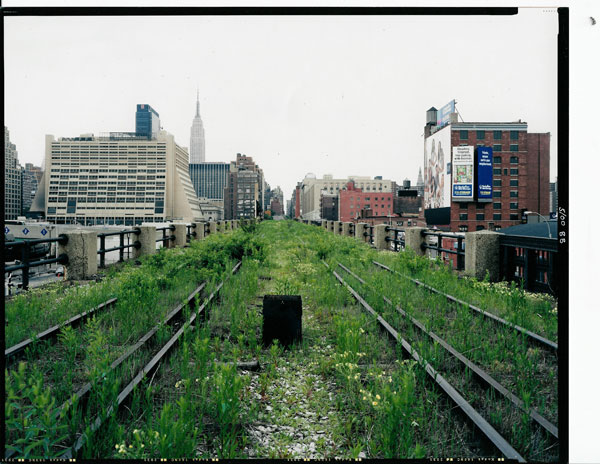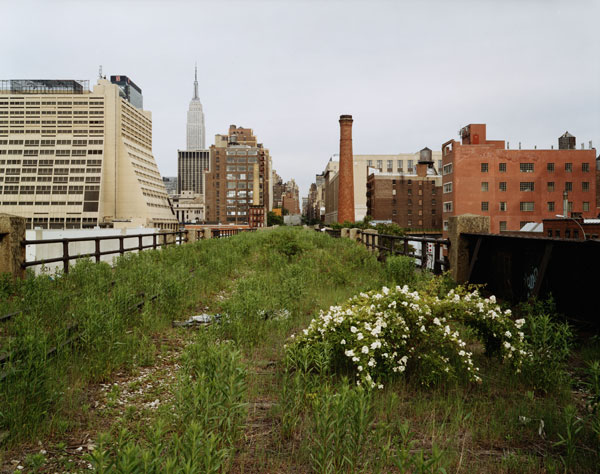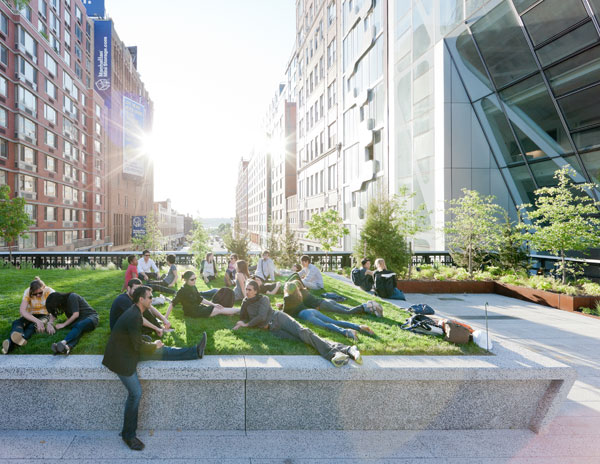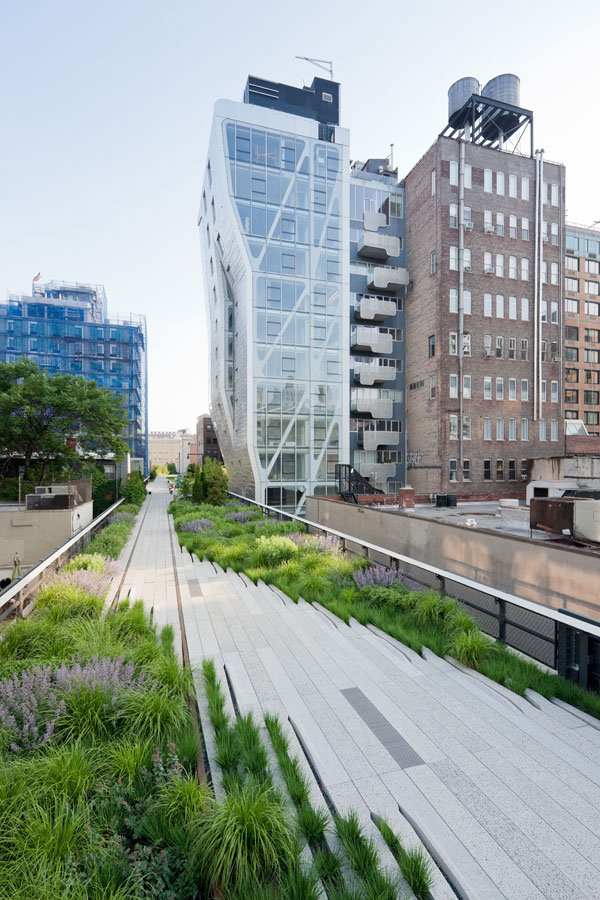News
Interview with Robert Hammond
 Robert Hammond / Image credit: Annie Schlechter
Robert Hammond / Image credit: Annie SchlechterIn the beginning of your and Joshua David’s personal story about transforming the abandoned High Line rail line into the most applauded park of recent years, The High Line: The Inside Story of New York City’s Park in the Sky, you say that early on, living in Chelsea you’d seen parts of the High Line, "but never realized all the bits and pieces connected." What did the High Line mean in your community? When did you first understand the space in its entirety?
I lived in the neighborhood so I had always seen it when walking around, but I didn’t think it was all connected. I really didn’t think that much about it until I read an article in The New York Times in the summer of ’99 that said it was threatened with demolition, and it included a map. The article showed that it was a mile and a half long running through the Meatpacking District and Chelsea, all the way up to Hell’s Kitchen near the Javits Convention Center. That’s when I first realized the whole extent of it.
I assumed someone would be working to preserve it. I called around and thought the American Institute of Architects or the Municipal Arts Society would be working on this. So many things in New York have preservation groups attached to them. But pretty quickly I found no one was doing anything for the High Line and that it was actually going to be demolished. I heard the proposed demolition was on the agenda for a community board meeting in my neighborhood so I went to my first community board meeting ever and sat next to Joshua, who I didn’t know at the time. By the end of the meeting we realized everyone in the room was in favor of demolition except for us. So we exchanged business cards and we said, “Well why don’t we start something together?”
Early on, you and Joshua had a multi-faceted strategy to keep the dream alive, to prevent the Guiliani administration from tearing down the High Line. You focused on building community support, visually documenting the site, creating design visions of what could be, while finding powerful advocates in the city government and also filing lawsuits. Which aspects of the strategy, in retrospect, proved to be most critical to moving the High Line forward in those early days?
Josh and I get a lot of credit for this great strategy. I think the most important thing we did was start the project, and it allowed other people to come along and help us get it done. In some ways, it was an asset that neither Josh nor I was an architect, landscape architect, or city planner. It forced us to basically go to other people for help. Talking to people who are interested in starting their own kind of project, that’s always the point I try to make: The most important thing that they can do is just start something. That enables other people to come along and help them get it done.
People always ask, “What was the one most critical time or event?” There wasn’t. The project had so many different pieces -- the political, the economic, real estate -- that there wasn’t one specific thing that made a difference. There were a whole bunch of different things. One of the things that I think is very interesting and that really connected the landscape and the ultimate design of the High Line were the photographs by Joel Sternfeld.
When Josh and I went up there, we realized what was right there in the middle of Manhattan. I first fell in love with the High Line from the street. I loved the structure, the rivets, but then when I walked up there, there was a mile and a half of wildflowers running right through the city. That’s what I really fell in love with: the combination of this wild landscape on top of this industrial structure in the middle of the city. We knew most people were never going to see it like this so we took our snapshots which just didn’t look that great. They didn’t really capture the impact of it. So I got a photographer named Joel Sternfeld to go up there and over the next year, between 2000 to 2001, he took a few pictures in all four seasons. He ultimately published a book called, Walking the High Line, back in 2002. Josh and I think of him as the third co-founder because those photographs of the wild landscape are what really helped galvanize people. I realized the most effective way to bring people on board was to show them the photographs, talking less and taking more time for people to experience the High Line through the photographs. Joel’s images really made the case for the project.
 A Railroad Artifact, 30th Street, May 2000 / Joel Sternfeld © 2000
A Railroad Artifact, 30th Street, May 2000 / Joel Sternfeld © 2000In the beginning, we didn’t know what the High Line should ultimately look like. We didn’t know exactly what the design should be. We always thought the community and the city should decide what it should be. Over time, people coalesced around Joel’s photo and when you asked them, “What do you want the High Line to be?” they’d point to Joel’s photos and they’d say, “I want it to be like that.” In some ways, that was the biggest inspiration behind the design, Joel’s photos of the landscape.
 Looking East on 30th Street on a Morning in May, 2000 / Joel Sternfeld © 2000
Looking East on 30th Street on a Morning in May, 2000 / Joel Sternfeld © 2000Getting the Bloomberg administration behind the effort meant coming up with a solid economic feasibility study, which you had to raise lots of funds to do. The study came up with the idea of transferring developers’ air rights and rezoning the area for commercial development. As the High Line developed, it has helped spur literally billions of dollars of new property development with a number of buildings by many marquee architects going in. Was that part of the original plan?
It was. We knew that the High Line had to make economic sense in the long-run, so we realized that for some people pretty pictures weren’t enough. We also needed an economic impact study, which is a really powerful tool for people working on parks projects because landscape, park, and public space projects can have a tremendous economic impact. Too often people just rely on what it looks like to make the case.
Of the design teams you invited to participate in the competition you said, “If I could do it over again, I’d require a landscape architect to be in the lead." Why?
I think it’s really important. In the beginning I didn’t feel that way. I thought it would make sense for an architect to be a lead, but this is truly a landscape project. There are some architectural problems, but one of my favorite quotes is from one of our architects, Ric Scofidio, who said his job was to save the High Line from architecture. We were lucky to have that kind of architect. But going back, it’s really a landscape issue. When I talked to architects about their concept it was all additives, about adding things to the High Line. Landscape architects are better at dealing with existing conditions. Landscape architects almost always have some existing conditions, whereas architects are used to beginning from scratch. The existing condition was so important to us and had such a deep connection with the history and what people fell in love with, and James Corner recognized that.
I can’t emphasize it enough: too many times, I've seen people doing public spaces mesmerized by architects. For better or worse, architects have a higher profile. Architects are the name brands in public spaces. How many landscape architects can the average person name? It’d be zero that are alive. But they know architects. However, I think that’s changing. James Corner, Michael Van Valkenburgh, Hargreaves. It's starting to change, but I think it’s just so critical for people not to be mesmerized by the famous names of the architects. What is really needed is experience working with existing stuff.
You say that a line from the book, The Leopard, sums up really your design philosophy for the High Line. “If you want things to stay as they are, things will have to change.” You had wanted to preserve the wild plants that had taken root on the abandoned tracks, but Piet Oudolf, a key part of the winning James Corner Field Operations and Diller Scofidio + Renfro team convinced you that you could create something as beautiful as the High Line in its natural state. How did the winning team change the High Line but keep it the same, preserving the idea of its natural state?
From the very beginning, they were arguing among themselves about this challenge of how do you keep what’s magic but at the same time create something new? What I liked is that they knew you couldn’t just preserve it exactly as is. That would be a mistake. If you just tried to keep it exactly as is, you would create some kind of Disney World version. It's coming back to that quote: you need to create something new to preserve that magical feeling.
Going up there by yourself where you had private garden was magical but what the design team was able to create was an experience that is really better with people in it. It looks better with people in it. Now when I see pictures of just the High Line without any people, I realize it wasn’t as good. It’s really beautiful when you have people interacting with the new landscape of the High Line. Also, the High Line has this unique ability to make people look better. People just look better on the High Line. I think that the landscape enhances that, too. The plants are able to do that in a way I think it’s hard for buildings to do.
 23rd Street Lawn, the northern end of the 4,900-square-foot lawn peels up over West 23rd Street, looking West, toward the Hudson River. © Iwan Baan, 2011
23rd Street Lawn, the northern end of the 4,900-square-foot lawn peels up over West 23rd Street, looking West, toward the Hudson River. © Iwan Baan, 2011You also write that during the design competition you found James Corner Field Operations and Diller Scofidio + Renfro to be "avant-garde," but dealing with details like bench width and comfort showed a "real practicality." How did the landscape architects, architects, and garden designer work with you and Joshua to realize your vision for the details of the park?
One of the reasons that sometimes things would come back more expensive is that the contractors had never done the things the designers were looking to do. Like the stairways, they came back and it was incredibly expensive. The designers calculated that it would be just as cheap to crush Mercedes-Benz and have them be the stairs as what the contractors did. The contractors were offering these high estimates just because they hadn’t seen this before. It wasn’t what they normally saw. For example, our paving wasn’t normal. But at the end of the day it wasn’t that complicated. Our paving system is really pre-cast concrete planks, so it’s just fancy parking curbs done in an array of different forms. Our design team would work with the contractor to help them understand how it was not that complicated or different from things they’d done in the past.
 A meandering pathway passes by old and new architecture in West Chelsea, between West 24th and West 25th Streets, looking south / © Iwan Baan, 2011
A meandering pathway passes by old and new architecture in West Chelsea, between West 24th and West 25th Streets, looking south / © Iwan Baan, 2011A number of cities now seem ready to jump on the High Line bandwagon. However, some landscape architects and planners caution that given the High Line was community-driven, it can’t really be replicated. Any copies may succeed as an economic development engine, but these projects may not get any true buy-in from communities. Do you think the High Line’s success can be replicated?
There are certain projects I really like, which have their own integrity. A lot of them are generated by communities. There’s the Bloomingdale Trail in Chicago, which was originally based in the community and came from a few people who lived in the area. The Atlanta Beltline, which is a much bigger ambitious project, started as one student's thesis. The Jersey Embankment right across the river is definitely a community-based project. A project has to have that spirit from below. I think the best ones are not trying to copy the High Line; they’re trying to be something new altogether. This is the test to determine success: whether they try to create something original just like the High Line did or not.
I have my personal goals for the High Line: one is that it’s a well-loved park by New Yorkers; two is that it gets better after Josh and I leave; and three (and most importantly) is that it inspires other people to start these kind of things -- not just elevated rail lines, but any kind of project. You don’t have to have experience, you don’t have to have all the money, you don’t have to have the plans all set. We developed all those things over time. That’s what stymies a lot of people. They think, “Oh, I don’t have the experience,” or, “I don’t have the money." Those things can come.
Well, you’ve just kind of answered the last question, but I’ll just throw it out there in case you have anything else to add. What advice would you have for other community groups trying to save and perhaps transform their local infrastructure and cultural assets, whatever they may be? What advice would you have for the landscape architects partnering with them?
There’s no perfect way to do it. The most important advice is just start it and experiment. Just try things. There’s no one specific path. There are multiple ways to get started. Now a great way to do these things and galvanize a project is Facebook. Start a Kickstarter account -- I’ve seen that working a lot now. One of the really important things is to raise money. It also helps start building the community. Whether someone gives five dollars, five thousand, or five million dollars, when they give money they become more invested in the project. It’s literally skin in the game. It’s an important part of building an organization or a whole movement.
We had a lot of people donate their time and energy to this project before it got off the ground. By finding community groups that need help, landscape architects and architects can, in effect, create more clients for themselves. Landscape architects can donate their services, get involved in local spaces, or just create their own.
Robert Hammond is Co-Founder and Co-Executive Director of Friends of the High Line, the non-profit conservancy that manages the High Line, a public park built atop an abandoned, elevated rail line on the west side of Manhattan. Hammond was awarded a Rome Prize from the American Academy in Rome, as well as the Rockefeller Foundation’s Jane Jacobs Medal for New Ideas and Activism.
Interview conducted by Jared Green.